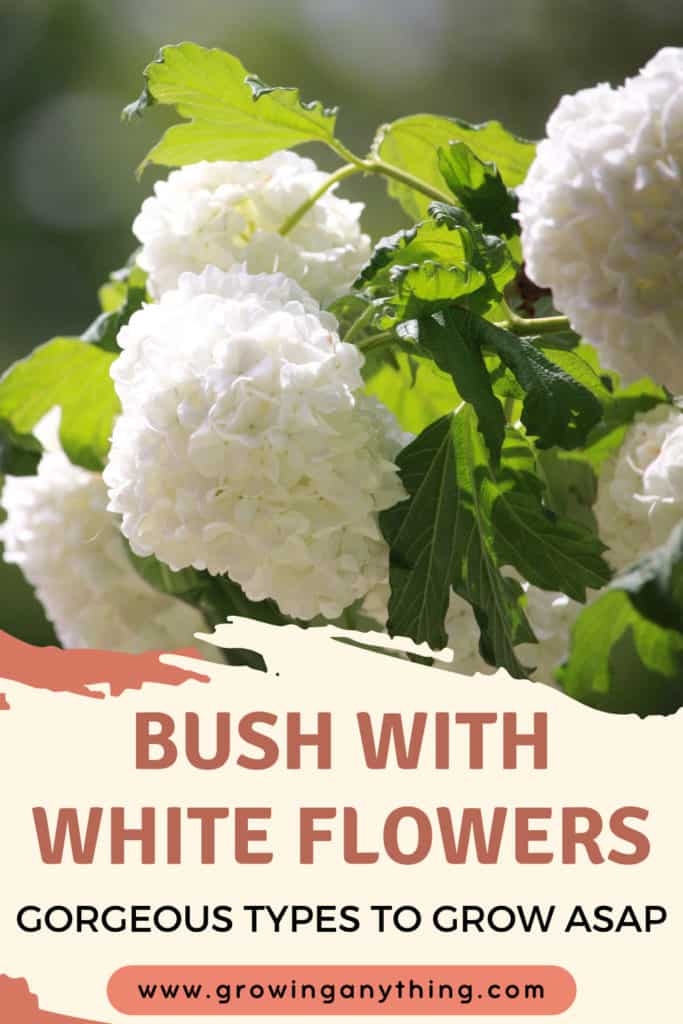26 Difference Types of White Flowers
Are you looking for a bush with white flowers to grow in your garden? Keep reading for the 26 ideas you can grow! These plants are real head-turners because of the elegant appearance and contrast between lovely green foliage and pure white blooms.
But, before you decide which bush with white blooms to pick for your garden, you need to get familiar with the proper care of the plant. Luckily, the list below contains this information as well!
Another great thing about these shrubs with white flowers is that they pair well with most other plants you already grow in your garden. So, what are you waiting for? Check the list and find the plants to grow as soon as possible.
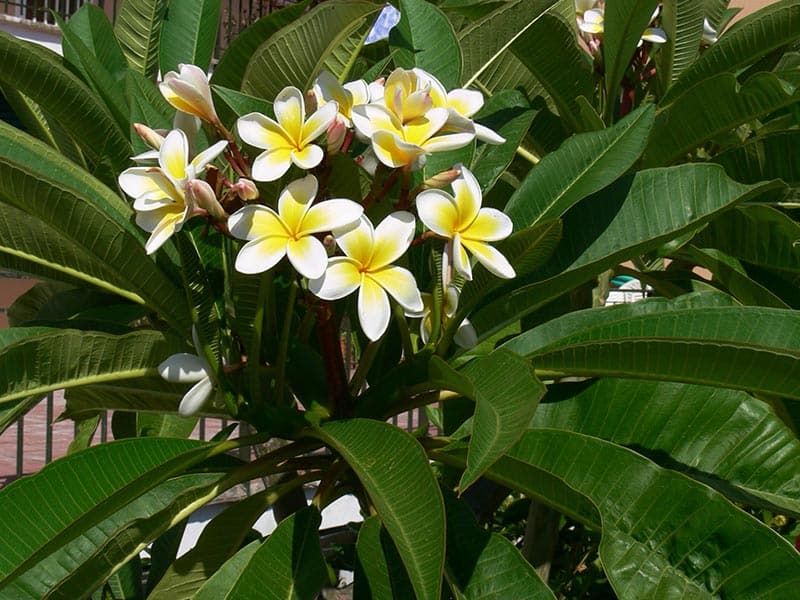
#1 White Hydrangea Shrubs
Hydrangea arborescens is such a great Hydrangea variety. The shrub develops showy white blooms and grows well in shady locations. Moreover, it can survive in conditions in which other shrubs’ white flowers won’t.
White Hydrangea shrubs are popular because they are versatile and pretty. You can use Hydrangea for landscaping and for adding dimension to flower beds. The shrub looks charming in all formal and informal gardens, mixed with neutral or colorful plants.
#2 Korean Spice Viburnum
Viburnum carlesii or Korean Spice Viburnum can reach six feet in height. The bush is low-maintenance but very rewarding. During the blooming season in the spring, the beautiful white flowers produce a captivating aroma.
Generally, the Korean Spice Viburnum needs a full sun location but may tolerate partial shade. The water and fertilization needs are moderate. I find that the Korean Spice Viburnum looks great on its own or when planted below trees.
The bush is a slow-grower, and suitable for medium-warm USDA hardiness zones.
#3 Star Jasmine
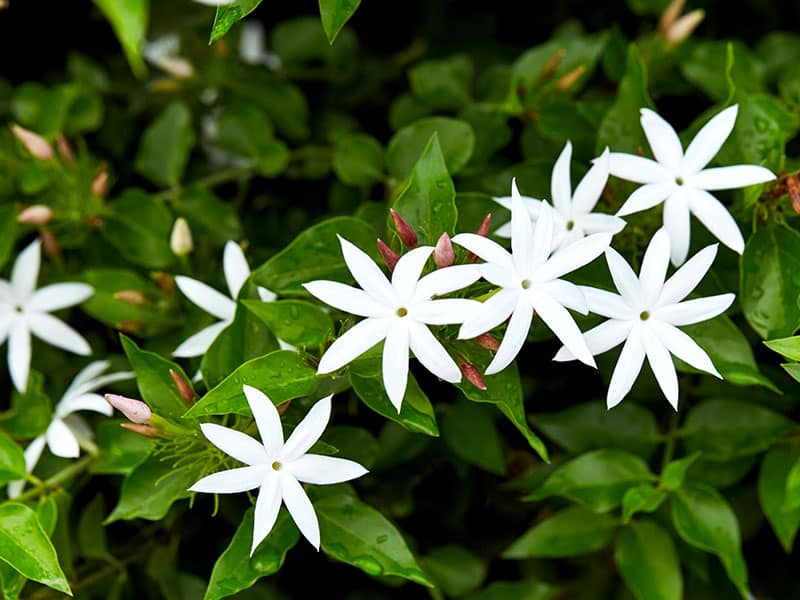
Jasminum multiflorum or Star Jasmine got the name because of the star-shaped white blooms. The pure white flowers stand out on the deep green foliage and give the plant an elegant look.
On its own, Jasmine produces a certain number of flowers. But, you can enhance that number by regularly removing diseased or dead stems. You can also shorten stems to stay in a tidy shape.
Remove the tangled stems to improve the air circulation and ensure even the lower parts of the plant receive enough sunlight.
The plant is adaptable to different soil and light conditions but requires minimum care.
#4 White Lilac Bushes
Syringa vulgaris or white lilac is an unusual and beautiful shrub, highly popular because it adds a special fragrance to your garden in addition to a beautiful appearance. Common lilacs are purple, and the variety with white blooms is called Madame Lemoine.
The plant loves humus-rich soil and full sun location. It doesn’t have any common problems and is deer-resistant.
You can plant it on the borders of the gardens or mix it with other plants to add dynamic and structure.
White Lilac needs pruning. Discover when it is the ideal time to prune the plant for the best results!
Interesting details about Lilac bushes.
#5 White Hibiscus
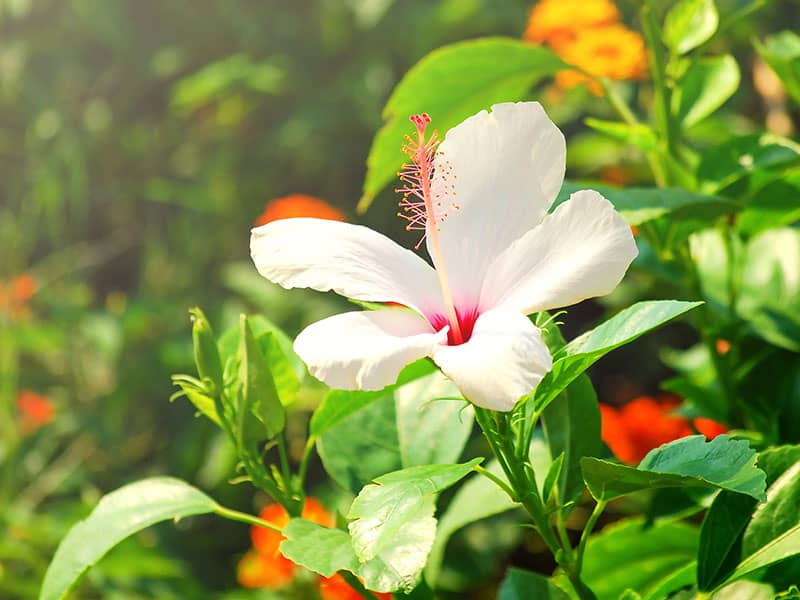
White Hibiscus, or botanically Hibiscus waimeae is an endemic species in Hawaii. The shrub may be trained to grow in the small tree appearance, in which case it can reach up to 15 feet. When growing as a shrub, White Hibiscus is significantly shorter.
The plant is gorgeous with large, five-petalled flowers with burgundy red centers.
If you live in Hawaii you can grow tropical Hibiscus plants very easily. White Hibiscus is easiest to grow from fresh seeds, but you can also grow it from semi-hardwood cuttings.
#6 White Rose Shrubs
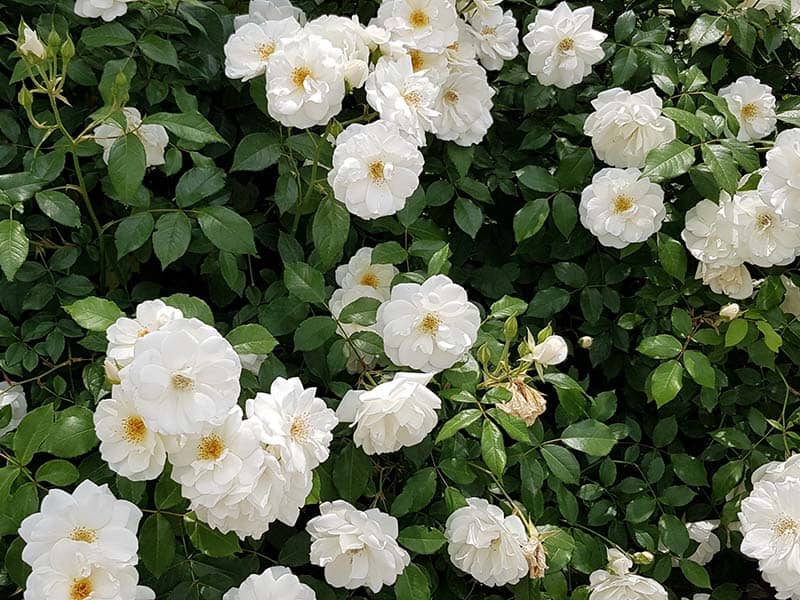
Rose shrubs symbolize love and romance, and the varieties with white blooms add sophistication, purity, and gorgeousness to the equation!
The ideal location for white rose shrubs is a location that receives plenty of sunlight per day. The plant also needs excellent soil drainage and frequent use of fertilizer. Don’t forget to keep the soil moist, but not soggy.
Also, you’ll have to prune rose shrubs and the ideal time is early spring.
If you have never grown roses in your life, read the complete beginner-friendly guide for growing roses!
#7 Sweet Pepperbush
Clethra alnifolia or Sweet Pepperbush is native to seashores and woodlands, but you can also grow this deciduous shrub in your garden. It has an interesting appearance with numerous pointy branches which end with narrow white flowers. The plant rarely gets taller than eight feet and produces fragrant flowers.
It can survive in the shade, but Sweet Pepperbush loves the sun. Don’t forget to keep the soil moist and your bush will thrive.
#8 Cherry Laurel
Prunus laurocerasus is the botanical name of the plant you probably recognize as Cherry Laurel. It is a small tree or a shrub that blooms in spring. Typically, the shrub gets around 20 feet in height and spreads very wide.
Cherry Laurel is a resilient plant and survives in poor quality soil and polluted areas. On top of everything, the plant is a fast grower and helps provide shade or privacy.
However, Cherry Laurel isn’t completely pests-free, but it doesn’t develop too many issues.
#9 Weigela White Knight
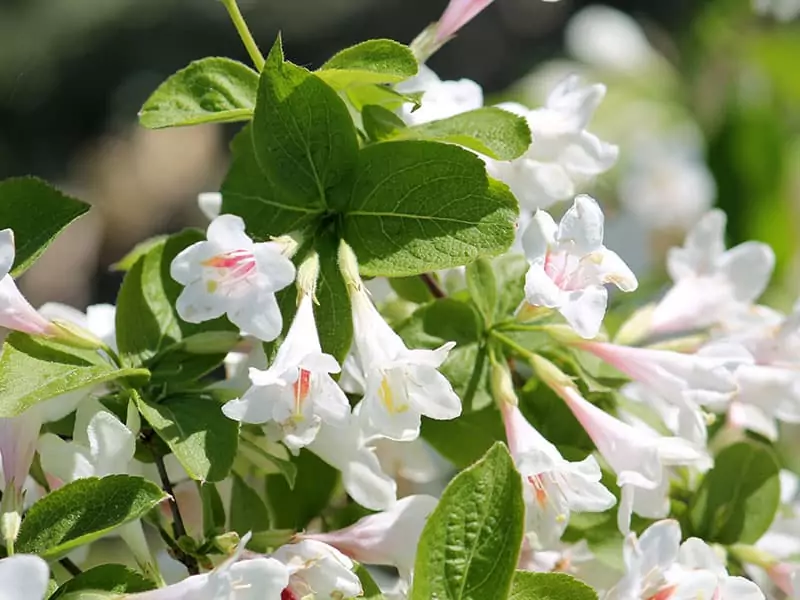
Weigela White Knight isn’t only a beautiful shrub with white flowers, but the blooms also look great as cut flowers.
The plant gets around five feet tall when fully matured. The flowers are showy and heavily fragrant and the main point of interest. It is because, outside the blooming season, Weigela White Knight doesn’t look very attractive.
The shrub grows best in full sun location but may tolerate shade. It doesn’t have any known pests and disease problems and looks great as a hedge or border plant!
#10 Japanese Andromeda
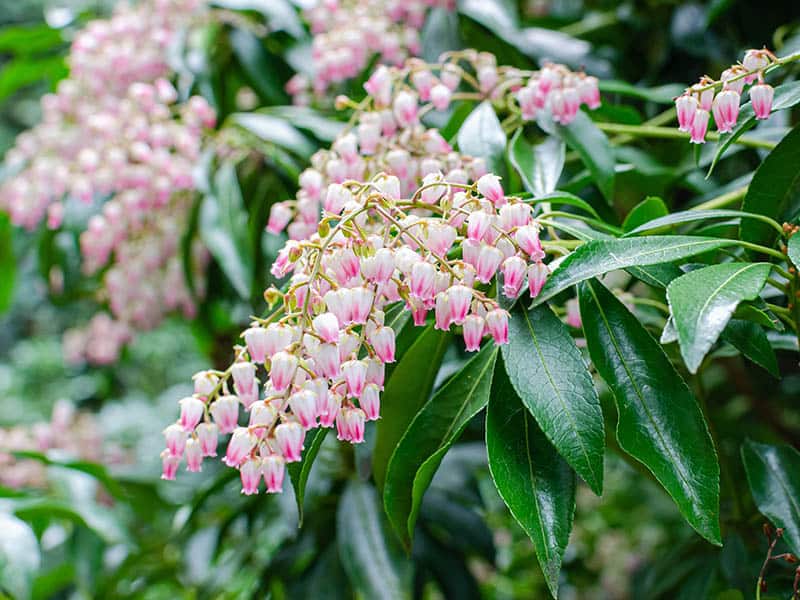
Pieris Japonica or Japanese Andromeda or Lily of the Valley plant is an evergreen shrub with ornamental foliage and attractive flowers. Leaves change color during seasons, and the plant blooms in spring. The flowers are creamy-white and appear in dangling clusters!
Japanese andromeda is a grout foundation plant, and you can also use it as a stand-alone plant or in shrub groupings. The variety called Purity develops large white flowers and stays shorter than most other Japanese Andromeda cultivars.
Discover the best growing tips for the Japanese Andromeda plant.
#11 Night Blooming Jasmine
Night Blooming Jasmine
Cestrum nocturnum or Night Blooming Jasmine is an unusual plant that opens its heavily fragrant flowers when the night comes! It isn’t a true Jasmine plant, but the fragrance and the appearance resemble Jasmine flowers. Because of the lovely aroma, Night Blooming Jasmine is great to plant near windows and patio.
The plant gets between eight and ten feet tall and can also be used as a hedge or for privacy.
Here are things to know about Night Blooming Jasmine.
A closer look at Night Blooming Jasmine with great growing tips.
#12 Virginia Sweetspire
Itea virginica or Virginia Sweetspire is a beautiful shrub that often gets around eight feet in height. The plant is most recognizable by its white flowers that appear in four inches spirals. The spirals hang from the branches and stay open for quite a long time.
Because of the lovely blooms and reddish leaves in the fall, the plant has high ornamental value. You can use it as a single specimen, but it looks better when blended in similar surroundings.
Discover the ideal growing conditions for the Virginia Sweetspire.
#13 Cinquefoil White
Potentilla Alba or Cinquefoil White is one of the most resilient plants on my list. Cinquefoil White is a disease, pest, deer, and drought-resistant, and very easy to grow! The ideal conditions for growing this lovely bush with white blooms are full sun location, moist and well-draining soil.
You can use it as ground cover, in the cottage garden, and on borders!
#14 Camellia White Swan
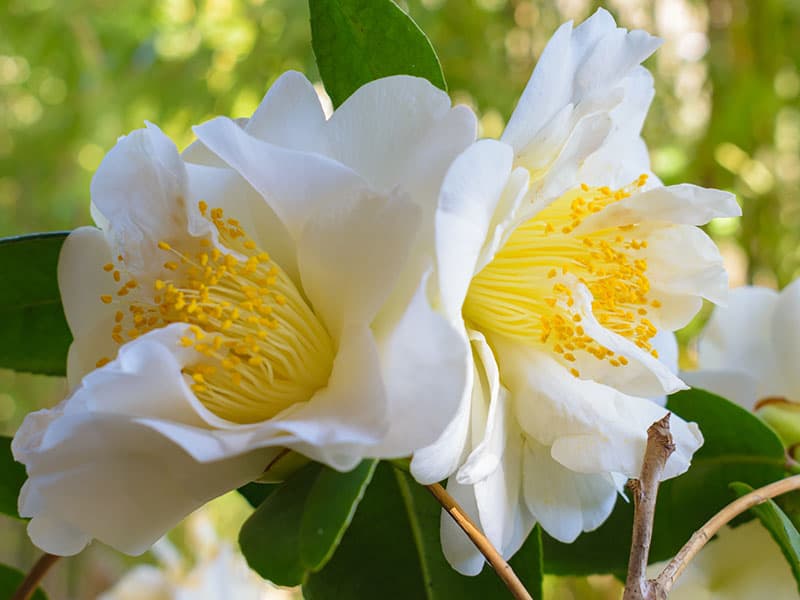
Camellia japonica variety White Swan produces stunning, eye-catching white flowers with multiple petals and distinct yellow centers. The plant is a real head turner with its upright growing habit and dense foliage. The shrub features leathery, rich green leaves, which make an excellent contrast with blooms.
The plant is evergreen and looks great wherever you plant it! Plant it in a partial shade and sheltered location for the healthiest growth. The ideal time for fertilization is mid-summer and mid-spring.
#15 White Spirea Shrubs
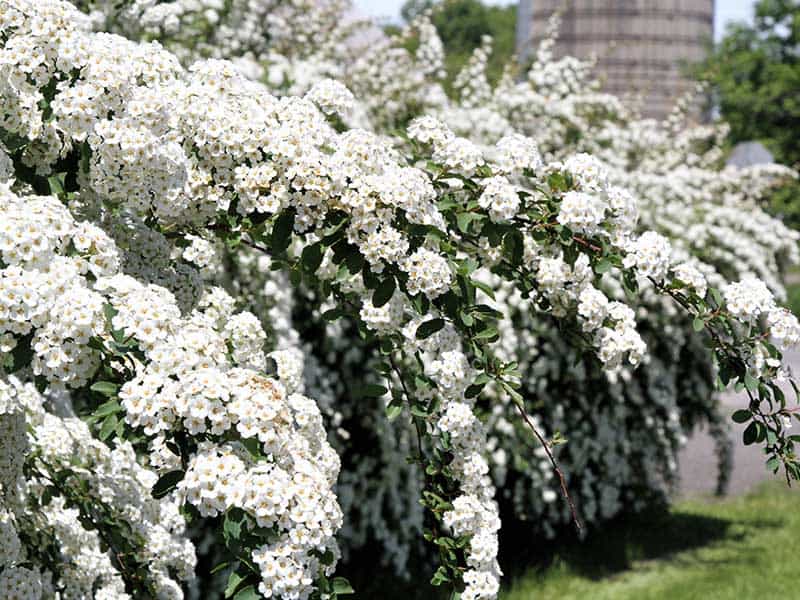
Spiraea alba shrub has a pleasant cascade growing habit and dense branching pattern. The plant develops large and beautiful flowers in different colors, and the white variety is my favorite one.
The maximum height it can reach is six feet, but the Spiraea only gets that tall when planted in a full light location.
Planting it in the shade will result in stunted growth and fewer flowers!
You can use the plant for privacy, on the borders, as a focal point in the garden, or as part of the larger groups.
#16 Pearlbush
Exochorda racemosa or Pearlbush is an unusual-looking plant with loose and upright growing habits. The plant is very tolerant to heat and drought and usually grows up to ten feet in height. The ideal growing conditions for Pearlbush are similar for the other bushes with white blooms – well-draining soil, sun or light shade location, and moderate moisture. However, the trick to keep the Pearlbush as healthy as possible is to grow it in acidic soil!
#17 Dogwood
Dogwood is a gardeners’ old-time favorite shrub or small tree with the botanical name Cornus Florida. Usually, Dogwood gets between 15 and 20 feet tall, but you can prune it to a more compact size.
Ideally, plant Dogwood in partial shade, in a location with plenty of morning sun. Overall, the tree is easy to care for but produces stunning white flowers in the second year after planting.
Check out more information on Dogwood, including anticipating problems with pests and diseases.
The best way to prune a large Dogwood tree, every step explained.
#18 White Azaleas
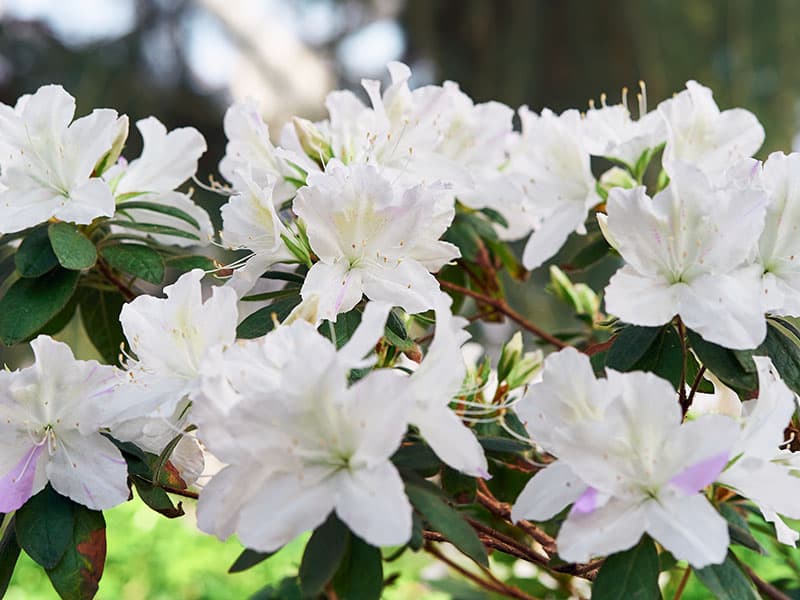
White Azaleas or botanically Rhododendron viscosum is a tall, deciduous shrub with high ornamental value and low-maintenance features. It features thick and glossy, true green foliage with white on narrow white stems. The blooms are scented with a sweet aroma!
Additionally, the plant blooms in spring and maintains flowers for a long time. Plant White Azaleas in partial shade in your garden, and keep the soil wet.
#19 Gardenia
Gardenia jasminoides is a charming bush with large and thick flowers shaped like lances. The pure white color of the blooms stands out against dark green leaves.
Gardenia jasminoides love moisture and partial shade. The beautiful large flowers resemble roses, but the foliage makes the differentiation simple. You can grow Gardenia in containers, on the borders, as a single-specimen plant, etc.
Find out all the ways you can propagate Gardenia.
#20 Plumeria
White Plumeria is often called West Indian Jasmine. The plant features succulent branches and beautiful elongated foliage with an almost leathery texture.
White Plumeria grows in a distinct umbrella shape, but you can prune it to maintain the shape you want.
Overall, white Plumeria is a slow-grower, but over the years, it can get very tall. The showy five-petalled flowers with bright yellow centers.
Check out how to grow white Plumeria from cuttings.
#21 White Flowering Magnolia Shrubs
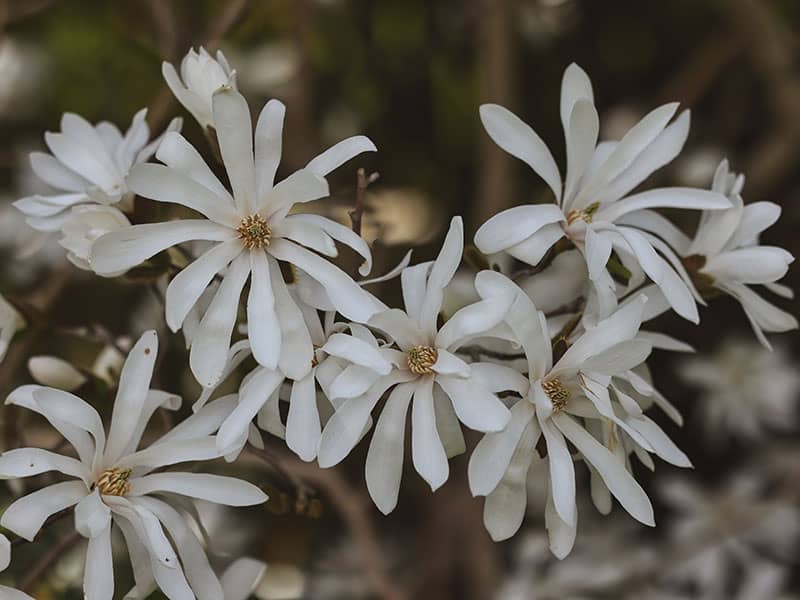
Magnolia stellata, or Star Magnolia develops wonderful white flowers in a star shape. It is an early bloomer and interestingly, blooms before then it develops the foliage. The blooms are fragrant with sweet aromas and sometimes have pink spots on them.
Magnolia has a compact growing habit and grows best in sheltered locations. In addition to its easy-going maintenance, the plant needs little pruning. All you have to do is remove dead branches in summer.
There are numerous varieties of Magnolia trees, and here is a complete guide that may help you to choose the best one for your garden.
#22 White Bougainvillea
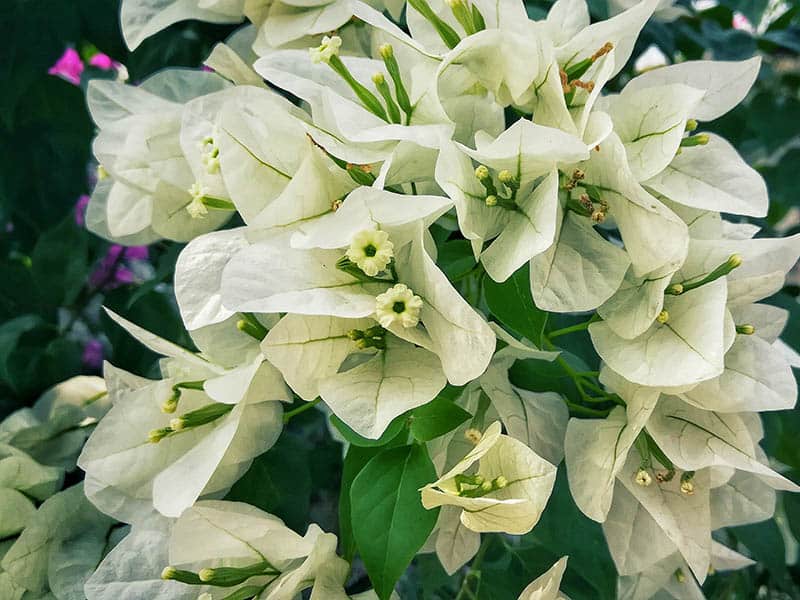
White Bougainvillea spectabilis is a spectacular woody shrub with heart-shaped foliage and tiny white flowers. The shrub may grow between 15 and 40 feet so you can use it for landscaping, as a focal point in your garden or shade.
Jamaica White is a variety with white flowers and Bougainvillea-exclusive bracts which allow planting to develop as a vine. You can support it with trellis or pergola for a stunning display.
Bougainvillea needs special care when first planted, but once it gets established it becomes a low-maintenance shrub.
#23 Wine Ninebark Summer Wine
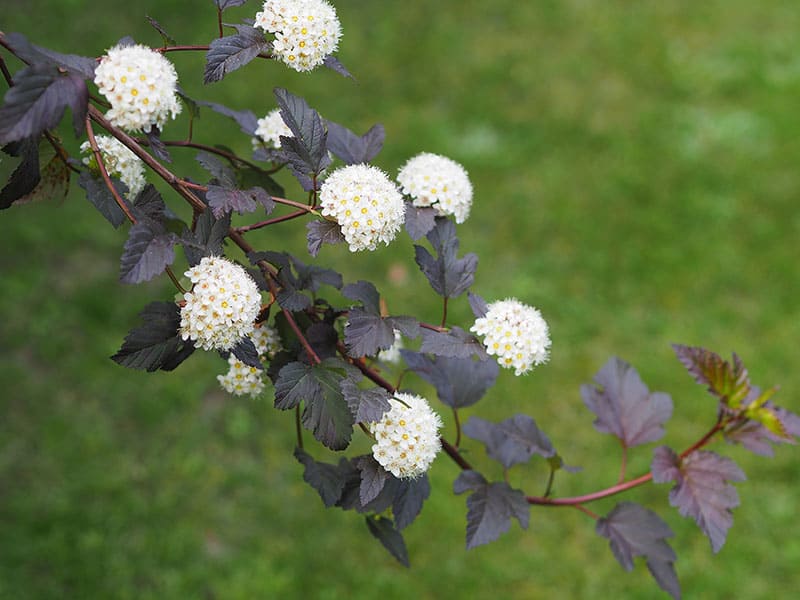
Physocarpus opulifolius or Wine Ninebark, variety Summer Wine has dark, almost purple foliage and small white flowers. The plant is adaptable and blooms summer long. It is also one of the rare plants with white flowers that are totally resistant to powdery mildew.
In addition to landscaping, Wine Ninebark blooms also make great cut flowers. Blooms also look charming when dried. Its distinctive look, Physocarpus opulifolius owes to is a cross between two varieties.
#24 False Holly
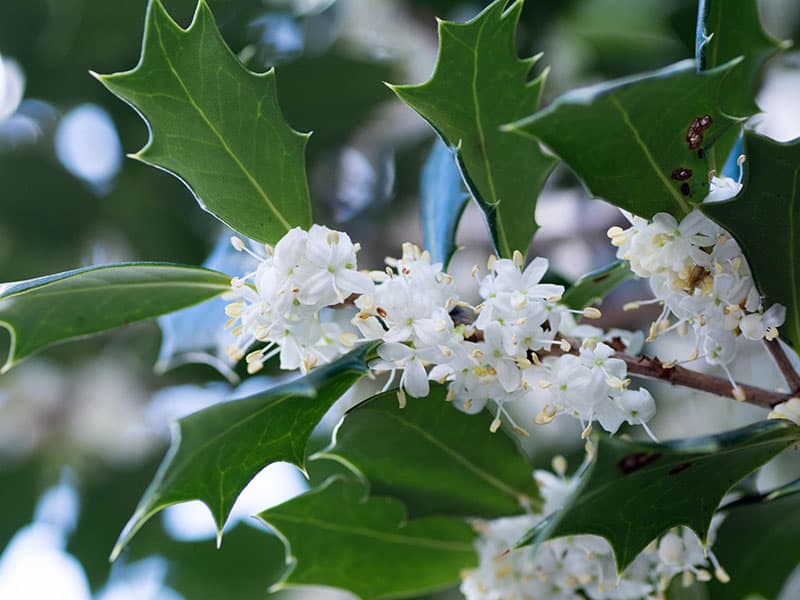
Osmanthus heterophyllus is a botanical name for the plant most people recognize as False Holly. The shrub grows in oval shape and features thick and dense branching.
Because of the opposite narrow and evergreen leaves with pretty spiny teeth, the shrub is very attractive. The white and fragrant fall flowers are an additional plus!
The plants grow in both sun and shade locations, but it develops more flowers in sunny areas. Pruning is an important maintenance step for False Holly, and you should do it in spring.
#25 Oleander
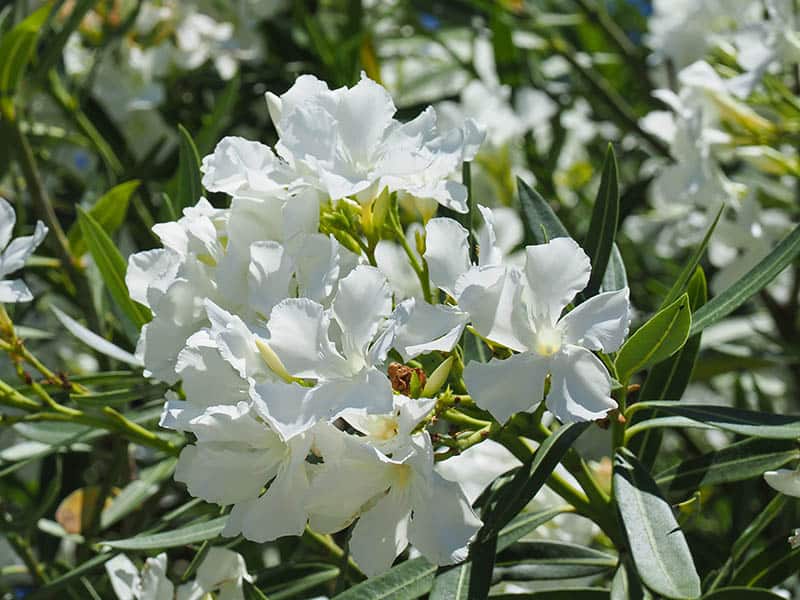
The infamous Nerium Oleander or White Oleander is an evergreen shrub that can survive a lot in warm climates, including drought and wet periods. Oleander grows fast and is resistant to wind. Therefore, it is often used around the roads as a reliable windbreak.
White Oleander develops large white, deeply-lobed blooms. Standard varieties may grow up to ten feet, while dwarf cultivars are significantly shorter.
Analyze the ideal growing care for white Oleander and decide whether it is a shrub for you.
#26 Deutzia
Deutzia gracilis Nikko is a lovely adaptable short-growing shrub. It can grow in cold climates and very polluted areas. In fact, Nikko is considered an invasive plant in different locations. However, if you want to keep your Deutzia under control, all you have to do is prune the plant to ensure it stays compact.
It is great for filling the empty spaces in your garden and doesn’t require much care.
Elegant Bush With White Flowers Ensures Endless Possibilities
The shrubs from my list are great for landscaping. They can make every garden showy and beautiful during the blooming season. But, most of the shrubs with white blooms can be used for privacy, as a single specimen, as a border plant, as part of the large shrub group, etc. They are also great as simple bald-spot-filling plants!
Which one is your favorite? I vote for white Magnolia!
I hope you find the list useful for your inspiration! If you do, please share it with your friends and family!
